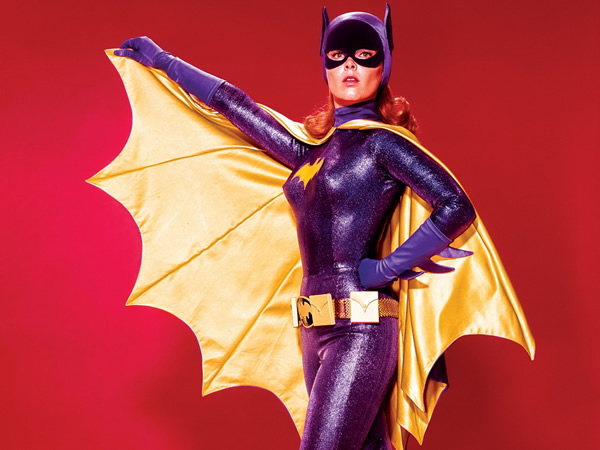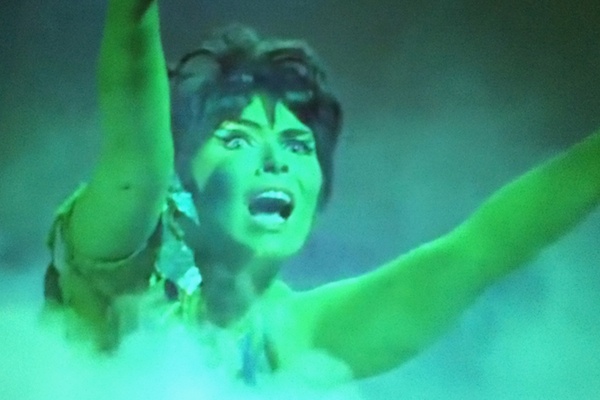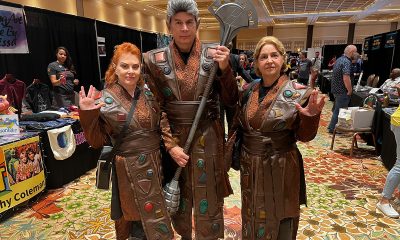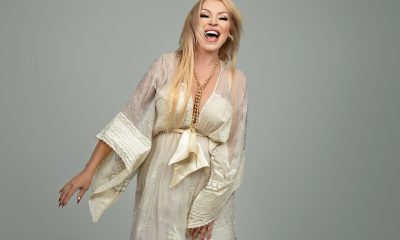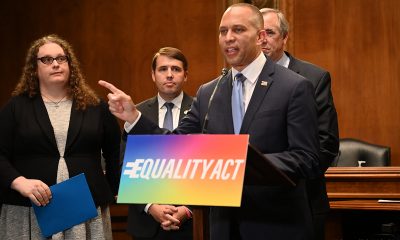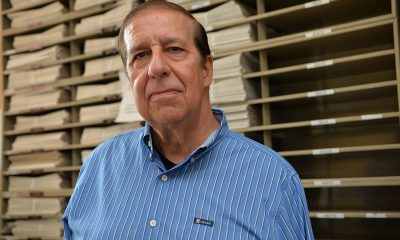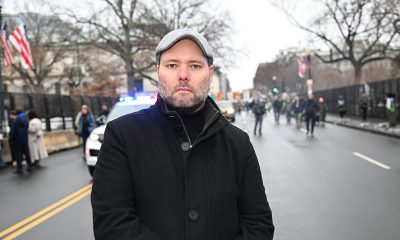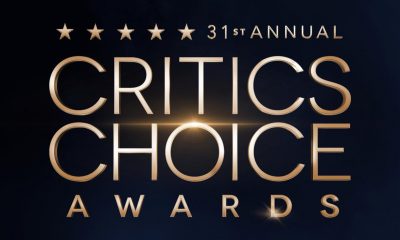a&e features
Holy spandex tights! It’s Batgirl!
Nearly 50 years later, Yvonne Craig reflects on ‘Batman,’ ‘Star Trek,’ Elvis and more
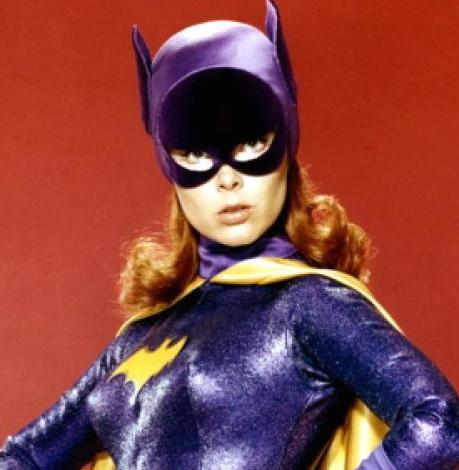
Sometimes indelible pop culture impressions are made in a very short time. Yvonne Craig played Batgirl for just one season — the third and final — of the 1966-’68 TV series “Batman,” yet it’s the role she’s best known for nearly 50 years later.
And although the character appeared once on the big screen (in the oft-derided 1997 movie “Batman & Robin” in which she was portrayed by Alicia Silverstone), it is Craig, by far, who is most identified with the role.
Craig, 77, was a steadily working actress throughout the 1960s and beyond racking up appearances on “Perry Mason,” “The Barbara Stanwyck Show,” “My Three Sons,” “The Many Loves of Dobie Gillis” and — donning head-to-toe green body paint — as Marta, an Orion slave girl, in the classic “Star Trek” episode “Whom Gods Destroy.” She also played opposite Elvis Presley in two feature films — “It Happened at the World’s Fair” (1963) and “Kissin’ Cousins” (1964). She was brought on “Batman” for the 1967-’68 season to play Commissioner Gordon’s librarian daughter Barbara whose alter ego Batgirl could be counted on to ward off villains with Batman (Adam West) and Robin (Burt Ward).
After years of legal wrangling, the series was finally released on DVD and Blu-ray last November. That was our initial peg for reaching out to Craig, but several delays including gall bladder surgery for the otherwise-healthy actress, pushed things back. We spoke to her by phone from her Los Angeles home two weeks ago. Quick to laugh and always ready to launch into a funny anecdote, Craig — who’s straight and happily married — was willing to indulge any inquiry. Her comments have been edited for length.
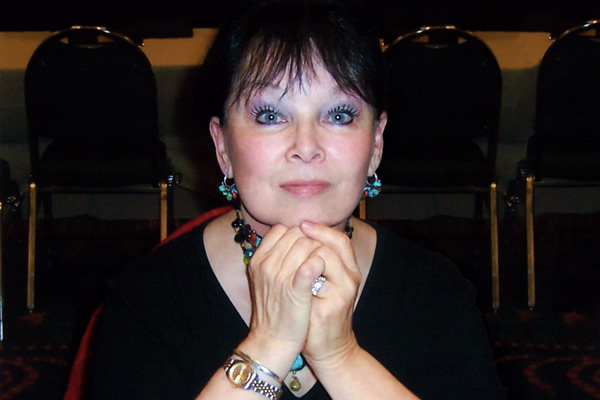
Yvonne Craig says she enjoys meeting fans though she has rarely watched ‘Batman’ or ‘Star Trek’ since their original broadcasts. (Photo courtesy Craig)
WASHINGTON BLADE: Have you lived most of your adult life in Los Angeles?
YVONNE CRAIG: Yes. We moved up to Nevada, to south Lake Tahoe, about three years ago and we moved back last year and I’m so grateful to be back. You can only look at so many trees and eventually you say, “Where’s the classical music? Where’s the ballet company? Where’s the art museum?” Well, they’re not there.
BLADE: Let’s start with “Star Trek.” Sci-fi fans in general are often so ardent and you had such a major role on one of the most famous episodes of the iconic original series yet I’m sure for you at the time, it was just another job. What’s it like when you meet fans and they assume you’re going to be a walking encyclopedia of “Star Trek” ephemera?
CRAIG: Well, it’s been lovely for me and I loved the part. I did a convention where a young woman came up to my room to walk me down to where I was supposed to do a Q&A and I said to her, “There are so many weird people here,” and she said, “We’re all weird, we’re all misfits and the reason we like this is because we can all get together and understand one another and it’s the only place we’re really accepted by our peers.” And I thought, “Wow, that’s really insightful.” … I’ve always liked the fans and they’ve been charming to me. It’s just when they come up and say to me, “Do you remember the third rock on the left in the such and such,” and I say to them, “You know what? I’ve only seen two ‘Star Treks.’ One was mine and the other was ‘The Trouble with Tribbles,’” you know, the furry little things. (I’m told) “Whom Gods Destroy” is the second most popular episode after “Trouble with Tribbles.”
BLADE: Was it hard to relax between takes with the green body paint?
CRAIG: No, but getting it off at night was a disaster. I started with a shower at the studio, then I had to go home and take an oil bath, then take another shower. I think if I were doing it today, I would have just slept very carefully somewhere at the studio.
BLADE: Aren’t you glad you didn’t have to play her for several seasons?
CRAIG: Oh, wouldn’t that be horrible? We also had trouble making it stick during the day. We were at our wits’ end and it’s like the fourth day and finally … we found a makeup guy who could make it stick. He wasn’t really supposed to do it because at the time male makeup artists were not allowed to put body makeup on women, but I didn’t care. We brought him in and sure enough, he did the last two days and it never moved. It was great but we never told because he could have been fired. It’s so sexist I can’t believe it.
BLADE: Have you followed the various “Batman” film adaptations over the years? Do you have much interest in that?
CRAIG: Yes, I do. I liked Michael Keaton. I just loved him but in the second one, he got stuck with the Penguin and it had, like, six endings. You think it’s over and the Penguin is gone and he would come back spitting ink again. So I just knew immediately why when Michael Keaton said he’s not doing anymore, I knew immediately why. Who wants to be second banana to a penguin? … I thought George Clooney was just going to be terrific … and I thought Chris O’Donnell … would be a good match … then you get to the movie and it’s just awful. I don’t know what was going on, if George Clooney was just doing too many things at the same time so he didn’t think this out or something. Every time they mentioned that Alfred was ill, no Alfred isn’t just sick, Alfred is going to die, he just had this smirk. I’m like, “What’s funny about that? This is the man who brought you up, what is going on?” And then Chris O’Donnell just kept whining about a car and I thought, “God, I hate this movie.” I actually thought Alicia Silverstone would just be darling as Batgirl and I wrote her a note and said, “You’ll just knock ‘em dead.” … First of all, they made her whole relationship she was Alfred’s niece or something instead of Commissioner’s daughter, which was screwy, then they put them all in these Robocop outfits so they couldn’t even move, it was horrible. I didn’t like Val Kilmer but once they got Christian Bale, I loved it. I mean I really like him. He’s an excellent actor. So yeah, I keep up with them.
BLADE: They’ve gotten so dark. Why?
CRAIG: Well, when we first started there were people who remembered the (serial) films from the 1940s or whenever they did them and that was dark. So I think they are kind of of their time. We were busy being hippies and throwing flowers and love and peace and all of that and people were offended. They said, “This isn’t what Batman should be.” Those were the diehard ones. Now they’re all dead because it was a long time ago. The one with Michael Keaton, I thought was pretty dark and a couple of times you couldn’t see who was fighting whom, so you weren’t invested. If you can’t see who the villains are and who the good guys are, you lost interest. Then they got lighter for a while but our times have changed. I think we’re going back to dark because these are darker times. We have drive-by shootings and terrorists with no conscience. So I don’t know what the next thing might look like but I bet it will be scary.
BLADE: I guess “Batman v. Superman” (slated for 2016 release) is next.
CRAIG: Oh is it? Well, I may have to see that one.
BLADE: Should Batgirl be in it too? Do you feel any investment in these things as you hear of them?
CRAIG: No. I loved doing the role. I liked the way the writers wrote her. When people come up and say she was a role model, I always think, “Wow, I wish I had one of the writers next to me to hear this” because they’re really the ones who wrote this. Everybody forgets that the actor can only do anything with what they’re given. Writers never get the esteem they should have.
BLADE: Yes, but so many of the actors on the ‘60s show really became synonymous with the parts. When we think of the Riddler, we think of Frank Gorshin, we think of Cesar Romero (the Joker), we think of you as Batgirl and of Julie Newmar and Eartha Kitt as Catwoman. Why did that series have such impact?
CRAIG: Well it was a top-rated show and nothing had ever been seen before that looked quite like that. It was really a comic book that was live action so you saw “bam” and “pop” and all of those things you saw in a comic book. The colors were brilliant and they had this crazy thing where when the villain entered the camera was tilted. So it was innovative and unique for its time. There were a lot of things only the adults would have understood, double entendres, … yet it was safe to watch with kids because it wasn’t violent. You’re not seeing body parts and blood and guts and people shoot one another. … As far as being attached, I was only in the third season and I had a body of work before and I didn’t have a problem at all doing other things. I think Adam (West) was a whole other story because he has a very distinctive speech cadence. (Imitates West) “That’s just the way he talked — (pauses) — citizens.” When he’d go read for other parts, they just thought he was doing Batman so he had a hard time getting hired. … Now he’s doing voiceovers and it’s working for him again and I like that. He’s a nice man.
BLADE: Was the costume stretchy?
CRAIG: It was. I was used to being in leotards, so it was perfect for me. … It was easy to work in, easy to get in and out of and I did stunts, so it was easy to dance in, kick in and all those things. I had no problem with it. Lee Meriwether (Catwoman briefly in 1966) and I were on a panel together once and she said that was the most uncomfortable costume she has ever worn and it was kind of the same as mine, that same stretch fabric. I think it just has to do with whether you were used to wearing leotards or not and I was.
BLADE: Did you keep anything, the costume or any props or anything?
CRAIG: No, because it didn’t belong to me.
BLADE: That was your own hair as Barbara?
CRAIG: Yes. I told them I didn’t mind being a redhead as long as it was a wig, which it was and you saw it very prominently displayed in her secret room. A friend of mine at the time wanted to set me up with this guy. I was single then. She told him, “She plays Batgirl.” And he said, “Oh, well I like the little brunette better.” And I thought, “Oh he’s too dumb to go out with.”
BLADE: Was it a fairly chummy set?
CRAIG: Oh yes, the happiest set I’d been on since “Mod Squad.” … It was terrific. The cast liked one another, the crew liked one another and we all loved having all of these people on we’d never have worked with otherwise. I never would have worked with Milton Berle or Ethel Merman (otherwise). And they all loved it too because it was so different from anything else they’d ever done. It was a happy place to go to work every day.
BLADE: Burt’s (Robin) memoir was quite interesting.
CRAIG: Yes. I think he had a very vivid fantasy life.
BLADE: His (“Boy Wonder: My Life in Tights”) was quite different from yours (“From Ballet to the Batcave and Beyond”).
CRAIG: It was. He had asked me to write the foreword for his. I said sure, send it to me. He never did. He’d call and read me funny things and finally we were getting tight on time. I was leaving the country and he said he needed it so I sent him something that said, “I have not read this book.” (“Batman” writer) Stanley Ralph Ross said, “You can’t write a foreword to a book you haven’t read,” so I read the book and it was just relentlessly sexual. Even if it were true and it wasn’t, nobody wants to think of their little Robin as this voracious satyr. … I know there are different takes on things, but I can tell you truly in the third season, nothing happened on that set, nothing. And I can almost guarantee you nothing happened the first two seasons either. Now what they did when they were out on the road, I have no idea but as far as it happening on the set — he claimed he was behind scenery — but we were there working, they had somebody building on the next set we were going to use and we had stunt people, including me, off in a corner trying to figure out the fight scene. We shot those in three days. I mean it was just gangbusters, go! So I don’t know where he found the space or the time and I never saw any of it. … Plus we had children visiting the set almost every day.
BLADE: Would you have continued on another three or four seasons had it been renewed?
CRAIG: I would have. I loved doing it.
BLADE: How far into the season were you when you heard it wasn’t being renewed?
CRAIG: We had a wrap party for the third season and we all went home thinking we would be picked up and only when it was time to start shooting again did I hear we weren’t. So we never really had an over party. We just went home for Thanksgiving or Christmas or one of those and we didn’t know. And of course, we didn’t know 50 years later people were still going to be talking about it. We just said, “OK, on to the next job. What else do you have lined up for me?” because that’s the way the business runs.
BLADE: Alan Napier (Alfred) said once that Eartha Kitt (Catwoman on the third season) was “kind of marvelous” but complained a lot on the set. Agree?
CRAIG: I don’t know. In the scenes I had with her, she wasn’t complaining at all. She was a woman, oh boy, who was I would say rather conflicted and very insecure so who knows, she might have complained and he might have heard her or he might have had more down time sitting with her than I did because usually when I wasn’t shooting, I was off with the stunt people. But no. One time we did some kind of reunion-type thing and my husband was excited to meet her and she was just so nervous about doing this, I don’t know, it was like a talk show or something. And she said, “I’m sorry, I can’t meet him, I can’t meet anyone, I have to get myself together for this.” And I thought, “How strange — this is just a talk show.” But you know, her background was not wonderful. I can see it. You’re black, you’re in America, you purportedly said something not very nice to the first lady (Lady Bird Johnson). I didn’t see anything wrong with what she said, she was just asking a question. But you know, it probably adds up.
BLADE: I know you didn’t work with Julie Newmar (Catwoman, first two seasons) on the show but you’ve made appearances with her at various events since then. Have you gotten to know her at all?
CRAIG: Not really. At the conventions she’s done, she always arrives late but she has a great work ethic. Somebody said to her one day, “OK, Julie, so when you get up, what do you do?” And she said (slipping into Newmar’s purry voice) “Well — pauses — I put on a little makeup — pauses — and then I have some coffee …” And I figured, “OK, well, that’s why she’s always late,” but I’ll tell you what, she’s wonderful with the fans and she will stay until the last person sees her. There are a lot I could mention who don’t do that, so I think she and I have the best work ethic of the group.
BLADE: It was obviously such intentional camp. You seemed to play it very earnestly. Was it hard to find the right tone with the material?
CRAIG: No. I played it completely straight and that’s the clue. I think if the material is completely over the top, you play it straight and that makes it funny for the audience. If you play it with a wink, then it isn’t funny. This tends to happen a lot with child actors.
BLADE: Were you happy to see it finally released?
CRAIG: Yes. We don’t get any residuals or anything because, of course, there was no such thing as DVDs back then. I probably won’t watch it, but I’m glad to see it out. I live in the present and I don’t look back other than to say, “Well, that was a wonderful experience,” and if it weren’t a wonderful experience, as in the case of, say, Bill Shatner (Kirk on “Star Trek”), who I don’t think ever allowed anyone to have a wonderful experience with his acting, I just feel we only have a certain amount of time and I don’t want to spend it looking back.
BLADE: I saw a photo not long ago of you with Bill Bixby (“The Incredible Hulk”) and you were in a bathing suit. What was that from?
CRAIG: We were on “Courtship of Eddie’s Father” and “My Favorite Martian” together but I was never in a bathing suit. In those days, God, I sound like such a codger, they had Photoplay and these fan magazines, so they would set up these photo shoots. One time Adam took me out on his boat and we took pictures but it was just for photos, I had never been on his boat before or after.
BLADE: But you and Bill were friendly?
CRAIG: We dated! … We remained friends, but it just wasn’t a good match.
BLADE: They kept casting you as different girlfriends of Dobie Gillis. Did that seem odd to you at the time?
CRAIG: I don’t remember thinking that. I think I just thought, “Oh, I get to play somebody new.” Dwayne Hickman (Dobie) still cracks me up. My husband doesn’t understand it. He looks at me and says, “He’s not that funny,” and I just say, “To me, he is.” It’s like George Burns or Jack Benny. All I have to do is look at Dwayne and I laugh. I did four “Dobies,” I think. It’s really weird when I tell people who all I worked with. Once I even worked with (silent screen legend) Francis X. Bushman on (“Dobie” episode) “The Flying Millicans.” He played my father. He had this long gray hair and we were trapeze artists. To think that I actually worked with somebody who was in silent films!
BLADE: Lynda Carter said once that DC Comics reached out to her when they were going to change the Wonder Woman costume. Have they ever lent you any sort of Batgirl emeritus status or consulted you on anything over the years?
CRAIG: No, not at all.
BLADE: Both “Star Trek” and “Batman” were modest hits during their original runs but went crazy in syndication and ran forever. Any theories on why?
CRAIG: I honestly couldn’t tell you. I haven’t the foggiest idea. We only went three seasons and we were a mid-season replacement so it wasn’t even like they were long seasons. Some of those Westerns went on for like 22 years or something crazy.
BLADE: Like “Gunsmoke.”
CRAIG: Yes. And I hated doing Westerns.
BLADE: Did you do many?
CRAIG: Oh yeah, a whole slew of ‘em. “Wagon Train,” “Bronco.” As long as the horse hits his mark, they don’t care what you say. They figure, “OK, the horse is in place, she’s up there, we can always loop it.” It’s all predicated on a horse.
BLADE: Do you see any homoerotic subtext in Batman and Robin, either on the show or in any other incarnation?
CRAIG: I never really felt there was. I think a lot of people who were reading into that were not gay. It’s the homophobes who would say, “You know, an older man, I bet he’s diddling that kid.” People who do not understand homosexuality at all.
BLADE: Did you have a favorite villain?
CRAIG: Oh yes, Vincent Price (Egghead). Not because of the villainy, but any time you had down time with Vince Price, he was just wonderful. He was bright, he was curious, he had a great sense of humor, he knew a lot about art, he knew a lot about ballet. He was just very well informed and you knew he kept up.
BLADE: Did you know he was gay at the time?
CRAIG: Yes.
BLADE: How did you feel when you heard Elvis had died?
CRAIG: Oh dear. Well first, he was just the sweetest man. He was so polite and he took all this unsolicited advice from me, what he should do with his hair, crazy stuff like that. … When he died, the Dallas Morning News called me up, I was seeing my future husband at the time, and this reporter said (slipping into exaggerated Southern accent), “How did you feel when Elvis died, were you just devastated?” I said, “Well, no, because I think dead is really a thing just like alive except you have less choices to make.” And there was this dead silence. Finally she said, (returning to accent), “OK, well thank you very much.” He said to me, “Nobody understands what you mean when you say that,” and I just said, “Well, that’s her problem.” I was sorry he died so young. There’s a group up in San Francisco that are just huge Elvis fans. They have his leading ladies up to talk and I’ve been there and then they have an impersonator come out. When I was there, it was Elvis Herselvis, this rather fat, gay woman. She does a wonderful job.
BLADE: Have you kept much career memorabilia?
CRAIG: No, nothing. When I did the book, all the photos were from fans who’d sent them to me at one time or another. When Capital Cities bought ABC, they sent me a whole stack of pictures they were just going to otherwise throw away and said, “Do you want them?” But that was it. I don’t keep stuff. I probably don’t have much of a sentimental bone in my body.
a&e features
Queer highlights of the 2026 Critics Choice Awards: Aunt Gladys, that ‘Heated Rivalry’ shoutout and more
Amy Madigan’s win in the supporting actress category puts her in serious contention to win the Oscar for ‘Weapons’

From Chelsea Handler shouting out Heated Rivalry in her opening monologue to Amy Madigan proving that horror performances can (and should) be taken seriously, the Critics Choice Awards provided plenty of iconic moments for queer movie fans to celebrate on the long road to Oscar night.
Handler kicked off the ceremony by recapping the biggest moments in pop culture last year, from Wicked: For Good to Sinners. She also made room to joke about the surprise hit TV sensation on everyone’s minds: “Shoutout to Heated Rivalry. Everyone loves it! Gay men love it, women love it, straight men who say they aren’t gay but work out at Equinox love it!”
The back-to-back wins for Jacob Elordi in Frankenstein and Amy Madigan in Weapons are notable, given the horror bias that awards voters typically have. Aunt Gladys instantly became a pop culture phenomenon within the LGBTQ+ community when Zach Cregger’s hit horror comedy released in August, but the thought that Madigan could be a serious awards contender for such a fun, out-there performance seemed improbable to most months ago. Now, considering the sheer amount of critics’ attention she’s received over the past month, there’s no denying she’s in the running for the Oscar.
“I really wasn’t expecting all of this because I thought people would like the movie, and I thought people would dig Gladys, but you love Gladys! I mean, it’s crazy,” Madigan said during her acceptance speech. “I get [sent] makeup tutorials and paintings. I even got one weird thing about how she’s a sex icon also, which I didn’t go too deep into that one.”
Over on the TV side, Rhea Seehorn won in the incredibly competitive best actress in a drama series category for her acclaimed performance as Carol in Pluribus, beating out the likes of Emmy winner Britt Lower for Severance, Carrie Coon for The White Lotus, and Bella Ramsey for The Last of Us. Pluribus, which was created by Breaking Bad’s showrunner Vince Gilligan, has been celebrated by audiences for its rich exploration of queer trauma and conversion therapy.
Jean Smart was Hack’s only win of the night, as Hannah Einbinder couldn’t repeat her Emmy victory in the supporting actress in a comedy series category against Janelle James, who nabbed a trophy for Abbott Elementary. Hacks lost the best comedy series award to The Studio, as it did at the Emmys in September. And in the limited series category, Erin Doherty repeated her Emmy success in supporting actress, joining in yet another Adolescence awards sweep.
As Oscar fans speculate on what these Critics Choice wins mean for future ceremonies, we have next week’s Golden Globes ceremony to look forward to on Jan. 11.
a&e features
Looking back at the 10 biggest A&E stories of 2025
‘Wicked,’ Lady Gaga’s new era, ‘Sexy’ Bailey and more

Although 2025 was a year marked by countless attacks on trans rights and political setbacks, the year also saw brilliant queer artists continuing to create art. From Cannes and Sundance Award winners now vying for Oscar consideration to pop icons entering new stages of their careers, queer people persevered to tell their stories through different media.
With the state of the world so uncertain, perhaps there’s no more vital time to celebrate our wins, as seen through some of this year’s top pop culture moments. While there’s no collection of 10 stories that fully encompass “the most important” news, here are some events that got the gays going:
10. ‘Mysterious Gaze of the Flamingo’ wins big at Cannes

The Cannes Film Festival has become a crucial start for films hoping to make their way to the Oscars, and first-time director Diego Céspedes won the top Un Certain Regard prize for his intimate western “The Mysterious Gaze of the Flamingo.” The film is set in the ‘80s and is intended as an allegory for the AIDS epidemic. Seeing a film that unpacks vital queer history win one of the most coveted awards at Cannes has been a huge point of pride in the independent filmmaking community.
Since the film bowed at Cannes, it has been selected as Chile’s Oscar entry in the Best International Feature race. Speaking with The Blade during the film’s AFI Fest run in October, Céspedes said: At first, I was kind of scared to have this campaign position in the times that we’re living [in] here. But at the same time, I think the Oscars mean a huge platform — a huge platform for art and politics.”
9. ‘The Last of Us’ returns for an even gayer season 2
While the first season of The Last of Us gave us one of TV’s most heartbreaking queer love stories in the episode “Long, Long Time,” Season 2 doubled down on its commitment to queer storytelling with the blossoming relationship between Ellie (Bella Ramsey) and Dina (Isabela Merced). The show expanded on the pair’s relationship in the original video game, making it perhaps the central dynamic to the entire season. That unfortunately came with more homophobic backlash on the internet, but those who checked out all the episodes saw a tender relationship form amid the show’s post-apocalyptic, often violent backdrop. For their performance, Ramsey was once again nominated for an Emmy, but Merced deserved just as much awards attention.
8. ‘Emilia Pérez’ sparks controversy
Jacques Audiard’s genre-bending trans musical “Emilia Pérez” proved to be an awards season juggernaut this time last year, winning the Golden Globe for Best Musical/Comedy. But when the lead star Karla Sofia Gascón’s racist, sexist, and homophobic old tweets resurfaced, the film’s Oscar campaign became a tough sell, especially after Netflix had tried so hard to sell Emilia Pérez as the “progressive” film to vote for. Mind you, the film had already received significant backlash from LGBTQ+ audiences and the Mexican community for its stereotypical and reductive portrayals, but the Gascón controversy made what was originally just social media backlash impossible to ignore. The only person who seemed to come out of the whole debacle unscathed was Zoe Saldaña, who won the Oscar for Best Supporting Actress over Ariana Grande.
7. ‘Sorry, Baby’ establishes Eva Victor as major talent
Back in January at the Sundance Film Festival, Eva Victor (known by many for her brand of sketch comedy) premiered their directorial debut “Sorry, Baby” to rave reviews, even winning the Waldo Salt Screening Award. Victor shadowed Jane Schoenbrun on the set of “I Saw the TV Glow,” and seeing Victor come into their own and establish such a strong voice immediately made them one of independent cinema’s most exciting new voices. A memorable scene in the film sees the main character, Agnes (played by Victor), struggling to check a box for male or female, just one example of how naturally queerness is woven into the fabric of the story.
Most recently, Victor was nominated for a Golden Globe for her performance in the film, and she’s represented in a category alongside Jennifer Lawrence (“Die My Love”), Jessie Buckley (“Hamnet”), Julia Roberts (“After the Hunt”), Renate Reinsve (“Sentimental Value”) and Tessa Thompson (“Hedda”). The film also received four Independent Spirit Award nominations overall.
6. Paul Reubens comes out in posthumous doc

While Paul Reubens never publicly came out as gay before passing away in 2023, the two-part documentary “Pee-wee as Himself” premiered back in May on HBO Max, giving the legendary comedian a chance to posthumously open up to the world. Directed by Matt Wolf, the documentary explores how Reubens found his alter ego Pee-Wee Herman and why he kept his private life private.
The documentary won an Emmy in the Outstanding Documentary or Nonfiction Special category and remains one of the most critically acclaimed titles of the year with a 100% Rotten Tomatoes score. Also worth noting, the National Geographic documentary Sally told the posthumous coming out story of Sally Ride through the help of her long-time partner, Tam O’Shaughnessy.
5. Lady Gaga releases ‘Mayhem’
Lady Gaga entered a new phase of her musical career with the release of Mayhem, her seventh album to date. From the frenzy-inducing pop hit Abracadabra to the memorable Bruno Mars duet featured on “Die With a Smile,” seeing Gaga return to her roots and make an album for the most die-hard of fans was especially rewarding after the underwhelming film releases of “House of Gucci” and “Joker: Folie à Deux.” Gaga has been touring with The Mayhem Ball since July, her first arena tour since 2018. She even extended her tour into 2026 with more North American dates, so the party isn’t stopping anytime soon. And Gaga is even set to make an appearance next May in “The Devil Wears Prada 2.”
4. Cynthia Erivo, Ariana Grande perform at the Oscars

While “Wicked: For Good” didn’t quite reach the heights of the first film, we will forever have Cynthia Erivo and Ariana Grande’s breathtaking live performance that opened the 97th Academy Awards. The pair sang a rendition of “Over the Rainbow,” “Home,” and “Defying Gravity,” paying proper homage to the original 1939 “Wizard of Oz.” Even non-Wicked fans can’t deny how magical and brilliantly staged this performance was. With both Erivo and Grande up for acting Oscars last year, they’re hoping to repeat success and make history with consecutive nominations. Either way, let’s hope there’s another live performance in the making, especially with two new original songs (The Girl in the Bubble and No Place Like Home) in the mix.
3. Indya Moore speaks out against Ryan Murphy
Indya Moore has consistently used social media as a platform for activism, and in September, posted a 30-minute Instagram live speaking out against “Pose” co-creator Ryan Murphy. Moore claimed that Murphy wasn’t being a true activist for trans people. “Ryan Murphy, we need you to do more. You need to address the racism, the violence, and the targeting of people on your productions, Ryan Murphy. You do need to make sure trans people are paid equally. Yes, Janet did the right thing,” Moore said. Murphy was also back in the headlines this year for the critically panned “All’s Fair” and the controversial “Monster: The Ed Gein Story” starring Laurie Metcalf and Charlie Hunnam.
2. Cole Escola wins Tony for Best Leading Actor
Few pop culture moments this year brought us together more than Cole Escola winning a Tony award for “Oh, Mary!” the Broadway show they created, wrote and starred in (we love a triple threat!) Escola made history by becoming the first nonbinary person to win a Tony in the leading actor category, and seeing them excitedly rush to the stage wearing a Bernadette Peters-inspired gown instantly became a viral social media moment.
The cherry on top of Escola’s major moment is the recent news that they are writing a Miss Piggy movie with Jennifer Lawrence and Emma Stone producing — news that also broke the internet for the better. We cannot wait!
1. Jonathan Bailey makes gay history as ‘Sexiest Man Alive’

The same year as his on-screen roles in blockbusters “Jurassic World Rebirth” and “Wicked: For Good,” Jonathan Bailey made history as the first openly gay man to be named People magazine’s “Sexiest Man Alive.” The fact that it took 40 years for an openly gay man to earn the title is a signifier of how far we still have to go with queer representation, and seeing Bailey celebrated is just one small step in the right direction.
“There’s so many people that want to do brilliant stuff who feel like they can’t,” he told PEOPLE, “and I know the LGBT sector is under immense threat at the moment. So it’s been amazing to meet people who have the expertise and see potential that I could have only dreamed of.” In 2024, Bailey founded the charity titled The Shameless Fund, which raises money for LGBTQ+ organizations.
a&e features
Your guide to D.C.’s queer New Year’s Eve parties
Ring in 2026 with drag, leather, Champagne, and more
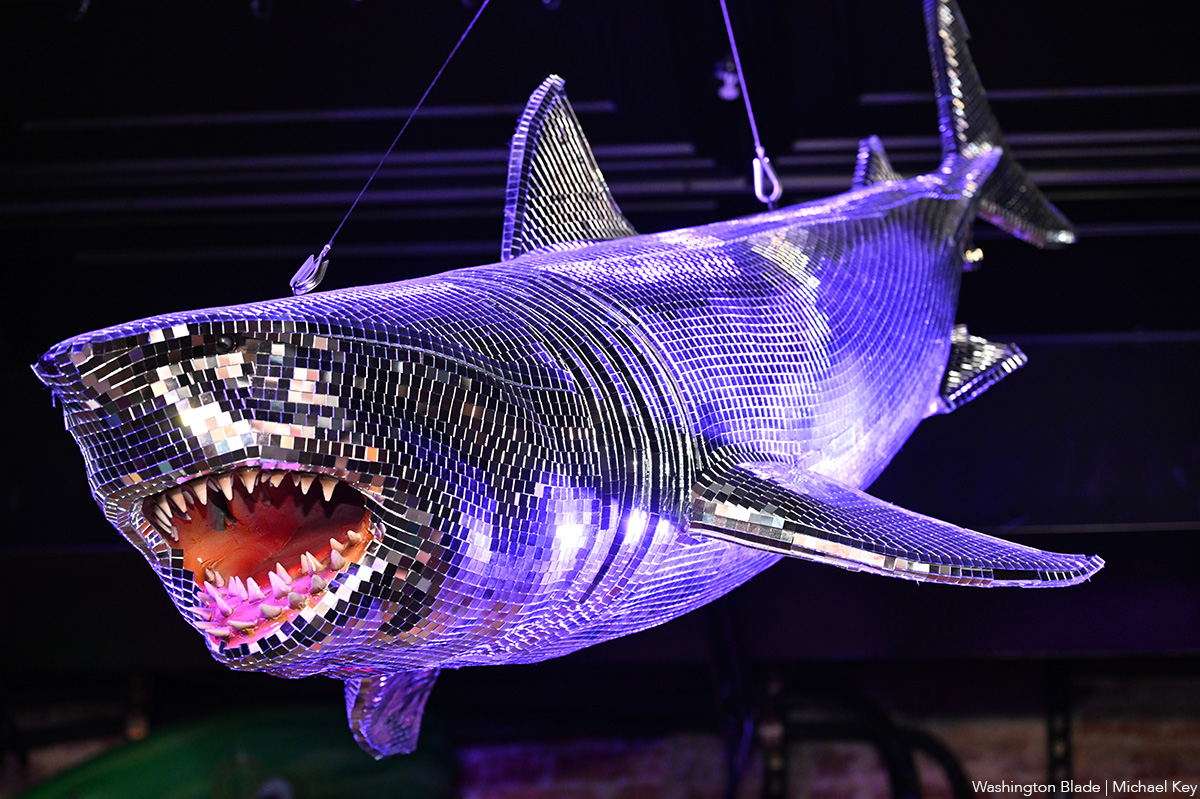
With Christmas in the rear view mirror, we can turn our attention to ringing in a much-anticipated New Year with a slew of local LGBTQ parties. Here’s what’s on tap.
Pitchers
This spacious Adams Morgan bar is hosting the “Pitchers’ Perfect New Year’s Eve.” There will be a midnight Champagne toast, the ball drop on the big screens, and no cover, all night long. The bar doesn’t close until 4 a.m., and the kitchen will be open late (though not until close). All five floors will be open for the party, and party favors are promised.
Trade
D.C.’s hottest bar/club combo is leaning into the Shark motif with its NYE party, “Feeding Frenzy.” The party is a “glitterati-infused Naughty-cal New Year’s Even in the Shark Tank, where the boats are churning and the sharks are circling.” Trade also boasts no cover charge, with doors opening at 5 p.m. and the aforementioned Shark Tank opening at 9 p.m.. Four DJs will be spread across the two spaces; midnight hostess is played by Vagenesis and the two sea sirens sensuously calling are Anathema and Justin Williams.
Number Nine
While Trade will have two DJs as part of one party, Number Nine will host two separate parties, one on each floor. The first floor is classic Number Nine, a more casual-style event with the countdown on TVs and a Champagne midnight toast. There will be no cover and doors open at 5 p.m. Upstairs will be hosted by Capital Sapphics for its second annual NYE gathering. Tickets (about $50) include a midnight Champagne toast, curated drink menu, sapphic DJ set by Rijak, and tarot readings by Yooji.
Crush
Crush will kick off NYE with a free drag bingo at 8 p.m. for the early birds. Post-bingo, there will be a cover for the rest of the evening, featuring two DJs. The cover ($20 limited pre-sale that includes line skip until 11 p.m.; $25 at the door after 9 p.m.) includes one free N/A or Crush, a Champagne toast, and party favors (“the legal kind”). More details on Eventbrite.
Bunker
This subterranean lair is hosting a NYE party entitled “Frosted & Fur: Aspen After Dark New Year’s Eve Celebration.” Arriety from Rupaul Season 15 is set to host, with International DJ Alex Lo. Doors open at 9 p.m. and close at 3 p.m.; there is a midnight Champagne toast. Cover is $25, plus an optional $99 all-you-can-drink package.
District Eagle
This leather-focused bar is hosting “Bulge” for its NYE party. Each District Eagle floor will have its own music and vibe. Doors run from 7 p.m.-3 a.m. and cover is $15. There will be a Champagne toast at midnight, as well as drink specials during the event.
Kiki, Shakiki
Kiki and its new sister bar program Shakiki (in the old Shakers space) will have the same type of party on New Year’s Eve. Both bars open their doors at 5 p.m. and stay open until closing time. Both will offer a Champagne toast at midnight. At Kiki, DJ Vodkatrina will play; at Shakiki, it’ll be DJ Alex Love. Kiki keeps the party going on New Year’s Day, opening at 2 p.m., to celebrate Kiki’s fourth anniversary. There will be a drag show at 6 p.m. and an early 2000s dance party 4-8 p.m.
Spark
This bar and its new menu of alcoholic and twin N/A drinks will host a NYE party with music by DJ Emerald Fox. Given this menu, there will be a complimentary toast at midnight, guests can choose either sparkling wine with or without alcohol. No cover, but Spark is also offering optional wristbands at the door for $35 open bar 11 p.m.-1 a.m. (mid-shelf liquor & all NA drinks).
-

 National3 days ago
National3 days agoWhat to watch for in 2026: midterms, Supreme Court, and more
-

 District of Columbia5 days ago
District of Columbia5 days agoTwo pioneering gay journalists to speak at Thursday event
-

 Colombia4 days ago
Colombia4 days agoBlade travels to Colombia after U.S. forces seize Maduro in Venezuela
-

 a&e features5 days ago
a&e features5 days agoQueer highlights of the 2026 Critics Choice Awards: Aunt Gladys, that ‘Heated Rivalry’ shoutout and more

